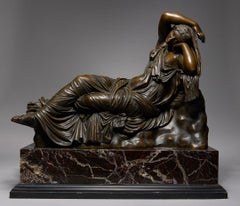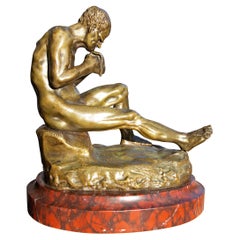Chiapparelli Nude Sculptures
to
1
Overall Width
to
Overall Height
to
1
1
1
1
1
1
1
1
1
1
2
86
31
28
23
1
Artist: Chiapparelli
Sleeping Ariadne, Large Bronze & Marble Sculpture of Greek Mythology, 19th C.
By Pietro Chiapparelli
Located in Beachwood, OH
Pietro Chiapparelli (Italian, 19th Century)
Sleeping Ariadne, c. 1865
Bronze on marble base
Inscribed 'P. Chiapparelli F.I. Roma'
22 x 24 x 10.5 inches
136 lb.
(34 lb. bottom marble,...
Category
1860s Chiapparelli Nude Sculptures
Materials
Marble, Bronze
Related Items
Profundus Bronze Sculpture Nude Boy Contemporary Male Figure Marble Stone
By Wim van der Kant
Located in Utrecht, NL
Profundus Bronze Sculpture Nude Boy Contemporary Male Figure Marble Stone
Wim van der Kant (1949, Kampen) is a selftaught artist. Next to his busy p...
Category
21st Century and Contemporary Contemporary Chiapparelli Nude Sculptures
Materials
Marble, Bronze
$16,234
H 22.05 in W 22.05 in
19th Century Bronze Sculpture "The Letter"
Located in Rochester, NY
Antique bronze sculpture of male nude reading a letter or proclamation. Marble base, 19th century. Unsigned.
Category
Early 19th Century Chiapparelli Nude Sculptures
Materials
Marble, Bronze
Luctatio Bronze Sculpture Nude Boy Male Figure Marble Stone
By Wim van der Kant
Located in Utrecht, NL
Luctatio Bronze Sculpture Nude Boy Male Figure Marble Stone
This sculpture need to be ordered. We will cast a brand new one for you. The edition is 8 (plus 4...
Category
21st Century and Contemporary Contemporary Chiapparelli Nude Sculptures
Materials
Marble, Bronze
$27,856
H 13.78 in W 15.75 in
Hoop Dancer
By Demetre Chiparus
Located in Los Angeles, CA
Demetre Haralamb Chiparus (also known as Dumitru Chiparus) (16 September 1886 in Dorohoi, Romania - 22 January 1947 in Paris, France) was a Romanian Art Deco* era sculptor who lived and worked in Paris.
He was born in Romania, the son of Haralamb and Saveta. In 1909 he went to Italy, where he attended the classes of Italian sculptor Raffaello Romanelli. In 1912 he traveled to Paris to attend the Ecole des Beaux Arts* to pursue his art at the classes of Antonin Mercie and Jean Boucher.
Demetre Chiparus died in 1947 and was buried in Bagneux cemetery, just south of Paris.
The first sculptures of Chiparus were created in the realistic style and were exhibited at the Salon of 1914. He employed the combination of bronze and ivory, called chryselephantine*, to great effect. Most of his renowned works were made between 1914 and 1933. The first series of sculptures manufactured by Chiparus were the series of the children.
The mature style of Chiparus took shape beginning in the 1920s. His sculptures are remarkable for their bright and outstanding decorative effect. Dancers of the Russian Ballet, French theatre, and early motion pictures were among his more notable subjects and were typified by a long, slender, stylized appearance. His work was influenced by an interest in Egypt, after Pharaoh Tutankhamen's tomb was excavated.
He worked primarily with the Edmond Etling and Cie Foundry in Paris administrated by Julien Dreyfus. Les Neveux de J. Lehmann was the second foundry which constantly worked with Chiparus and produced the sculptures of his models.
Chiparus rarely exhibited at the Salon. In 1923 he showed his Javelin Thrower, and in 1928 exhibited his Ta-Keo dancer. During the period of Nazi persecution and the World War II, the foundries discontinued production of work by Chiparus. The economic situation of that time was not favorable to the development of decorative arts and circumstances for many sculptors worsened.
Since the early 1940s almost no works of Chiparus were sold, but he continued sculpting for his own pleasure, depicting animals in the Art Deco style. At the 1942 Paris Salon, the plaster sculptures Polar Bear and American Bison were exhibited, and in 1943 he showed a marble Polar Bear and plaster Pelican.
Sculptures of Dimitri Chiparus represent the classical manifestation of Art Deco style in decorative bronze ivory sculpture. Traditionally, four factors of influence over the creative activity of the artist can be distinguished: Serge Diaghilev's Ballets Russes, ancient Egyptian art, and French theatre. Early motion pictures were among his more notable subjects and were typified by figures with a long, slender, stylized appearance. Some of his sculptures were directly inspired by Russian dancers.
Quite often, Chiparus used the photos of Russian and French dancers, stars and models from fashion magazines of his time.
After the tomb of Tutankhamun was discovered in 1922, the art of ancient Egypt...
Category
1920s Art Deco Chiapparelli Nude Sculptures
Materials
Marble, Bronze
Cursus Bronze Sculpture Contemporary Nude Boys Male Figures Marble Stone
By Wim van der Kant
Located in Utrecht, NL
Cursus Bronze Sculpture Contemporary Nude Boys Male Figures Marble Stone
Wim van der Kant (1949, Kampen) is a selftaught artist. Next to his busy profession...
Category
21st Century and Contemporary Contemporary Chiapparelli Nude Sculptures
Materials
Marble, Bronze
$18,446
H 18.12 in W 15.75 in
1920s Italian Art Decò Signed Bronze Sculpture Nude of Woman
By Gaetano Martinez
Located in Roma, IT
Wonderful Italian sculpture representing a seated maiden.
The artwork rests on a square marble base
Signed on the base “Gaetano Martinez Roma”
According a written opinion by Prof. Al...
Category
1920s Art Deco Chiapparelli Nude Sculptures
Materials
Marble, Bronze
$3,587
H 11.82 in W 5.52 in D 7.88 in
Tollit Bronze Sculpture Nude Boy Contemporary Male Figure Balance Marble Stone
By Wim van der Kant
Located in Utrecht, NL
Tollit Bronze Sculpture Nude Boy Contemporary Male Figure Balance Marble Stone
Wim van der Kant (1949, Kampen) is a selftaught artist. Next to his bu...
Category
21st Century and Contemporary Contemporary Chiapparelli Nude Sculptures
Materials
Marble, Bronze
Wim van der KantTollit Bronze Sculpture Nude Boy Contemporary Male Figure Balance Marble Stone, 1999
$13,608
H 20.08 in W 13.78 in
Fratres Bronze Sculpture Boys Brothers Male Nude Figure Marble Stone
By Wim van der Kant
Located in Utrecht, NL
Fratres Bronze Sculpture Boys Brothers Male Nude Figure Marble Stone
Wim van der Kant (1949, Kampen) is a selftaught artist. Next to his busy profess...
Category
21st Century and Contemporary Contemporary Chiapparelli Nude Sculptures
Materials
Marble, Bronze
$17,246
H 14.97 in W 14.57 in
David Bronze Sculpture Nude Boy Male Figure Marble Stone
By Wim van der Kant
Located in Utrecht, NL
David Bronze Sculpture Nude Boy Male Figure Marble Stone
Wim van der Kant (1949, Kampen) is a selftaught artist. Next to his busy profession as a teacher at ...
Category
21st Century and Contemporary Contemporary Chiapparelli Nude Sculptures
Materials
Marble, Bronze
$6,903
H 13 in W 11.82 in
Ira Bronze Sculpture Contemporary Nude Boy Marble Stone Sitting
By Wim van der Kant
Located in Utrecht, NL
Ira Bronze Sculpture Contemporary Nude Boy Marble Stone Sitting
Wim van der Kant (1949, Kampen) is a selftaught artist. Next to his busy profession a...
Category
21st Century and Contemporary Contemporary Chiapparelli Nude Sculptures
Materials
Marble, Bronze
$9,006
H 14.57 in W 3.94 in
Eo Sine Manibus Bronze Sculpture Nude Boy Male Figure Standing Marble Stone
By Wim van der Kant
Located in Utrecht, NL
Eo Sine Manibus Bronze Sculpture Nude Boy Male Figure Standing Marble Stone
Wim van der Kant (1949, Kampen) is a selftaught artist. Next to his busy profession as a teacher at a hig...
Category
21st Century and Contemporary Contemporary Chiapparelli Nude Sculptures
Materials
Marble, Bronze
$9,706
H 14.18 in W 5.12 in
Lucifer Evangilans Bronze Contemporary Sculpture Nude Boy Male Figure
By Wim van der Kant
Located in Utrecht, NL
Lucifer Evangilans Bronze Contemporary Sculpture Nude Boy Male Figure
Wim van der Kant (1949, Kampen) is a selftaught artist. Next to his busy profession as ...
Category
21st Century and Contemporary Contemporary Chiapparelli Nude Sculptures
Materials
Marble, Bronze
$24,301
H 32.68 in W 11.82 in
Chiapparelli nude sculptures for sale on 1stDibs.
Find a wide variety of authentic Chiapparelli nude sculptures available for sale on 1stDibs. You can also browse by medium to find art by Chiapparelli in bronze, marble, metal and more. Not every interior allows for large Chiapparelli nude sculptures, so small editions measuring 24 inches across are available. Customers who are interested in this artist might also find the work of Yann Guillon, Ryszard Piotrowski, and Benson Landes. Chiapparelli nude sculptures prices can differ depending upon medium, time period and other attributes. On 1stDibs, the price for these items starts at $9,000 and tops out at $9,000, while the average work can sell for $9,000.

